#50: Use Dialogue Tags for Rhythm and Cadence
In Northanger Abbey, Catherine Morland and her friend Isabella Thorpe are conversing in the Pump-Room, a building in the town of Bath that was a popular gathering place. For quite some time, they are watched by several men, but then the men leave. Isabella pretends that she is grateful for their departure; however, she is actually disappointed that they have left and secretly wants to follow them.
Isabella says:
“Well, I am amazingly glad I have got rid of them! And now, what say you to going to Edgar’s Buildings with me, and looking at my new hat? You said you should like to see it.”
Catherine readily agreed. “Only,” she added, “perhaps we may overtake the two young men.”
The key dialogue tag in this passage is she added. As we discussed in the previous lesson on dialogue tags, she added could be considered a functional dialogue tag, a dialogue tag which shows how what the character is saying is functioning within the larger conversation. First Catherine agrees with her friend, and then what she says adds to—and modifies—her previous statement.
Yet she added is doing more than just telling us the role that her statement plays in the conversation. Its placement controls the rhythm of the paragraph and indicates the cadence of Catherine’s speech.
Jane Austen regularly uses dialogue tags for rhythm and cadence, and doing so is a powerful tool that can be used in any fictional genre.
Let’s define rhythm and cadence as we’ll use them in this lesson.
Definitions: Rhythm and Cadence in Dialogue
Rhythm is patterns of language and sound in a passage which create an underlying beat. Poetry sometimes uses strict meters, or rhythm patterns, but there is rhythm in prose as well, and the beat and speed and emphasis created by the rhythm in prose effects both the feel and the speed at which we read. Rhythm is particularly important as we consider dialogue, for dialogue is meant to be spoken aloud. Rhythm can have a powerful effect on the reader both when a beat is created or when it is broken—interrupted.
Cadence is how a person’s voice changes as they speak, both rising and lowering. In most cases, a speaker’s voice is not level or flat across a passage of dialogue: tone and pitch and emphasis change with the content of what someone is saying, and how they feel about it.
Much of the rhythm and cadence of a passage of dialogue is determined by the words and phrasing of the dialogue itself, however, rhythm and cadence can also be impacted by the dialogue tags.
Let’s consider again the line from Northanger Abbey:
Catherine readily agreed. “Only,” she added, “perhaps we may overtake the two young men.”
We can almost hear Catherine’s cadence as we read. She agrees with her friend, probably saying something like, “Of course, I would love to join you.” And then we have an “Only,” she added. It reads almost as an interruption—she’s likely raised her voice slightly, and she’s pausing after it, as if she has just realized the problem with Isabella’s proposal.
During Isabella’s statement—the proposal of activities—and Catherine readily agreed we have a steady rhythm, almost a beat. It’s smooth, nothing accentuated. But then “Only,” she added breaks the smooth rhythm—the forced pause is like an orchestra suddenly stopping all sound for a beat, which adds emphasis to what comes after.
Dialogue Tag Placement
One of the most common techniques that Jane Austen uses to control rhythm and cadence is to choose where to use a dialogue tag, whether it’s a he said, said Catherine, or an action that substitutes for a dialogue tag.
Consider the following passage of dialogue, from the first time that Catherine Morland and Mr. Tilney meet at a ball:
Mr. Tilney was polite enough to seem interested in what she said; and she kept him on the subject of muslins till the dancing recommenced. Catherine feared, as she listened to their discourse, that he indulged himself a little too much with the foibles of others. – “What are you thinking of so earnestly?” said he, as they walked back to the ball-room;—“not of your partner, I hope, for by that shake of the head, your meditations are not satisfactory.”
Catherine coloured, and said, “I was not thinking of any thing.”
“That is artful and deep, to be sure; but I had rather be told at once that you will not tell me.”
If a dialogue tag is used, there are three primary places where it can be placed: before the dialogue, partway through the dialogue (often after a word, sentence, or phrase), and after the dialogue.
One approach that Austen particularly seems to favor is providing the tag partway through the dialogue. This allows a build-up before the dialogue tag—we’re interested in what is being said. Then we are given a physical pause or beat that also serves to provide who is speaking and sometimes how they are speaking or what they are doing. This is followed by more dialogue, which completes the character’s self-expression.
Instead of placing the dialogue tag in the middle of the paragraph, Austen could have written:
As they walked back to the ballroom, Mr. Tilney said, “What are you thinking of so earnestly? Not of your partner, I hope, for by that shake of the head, your meditations are not satisfactory.”
This eliminates the pause after his question—he immediately says the next statement. It also eliminates some of the implied cadence—modulation of his tone—in his question.
The dialogue tag could also have been placed at the end:
“What are you thinking of so earnestly? Not of your partner, I hope, for by that shake of the head, your meditations are not satisfactory,” said Mr. Tilney as they walked back to the ballroom.
Often, a dialogue tag at the end works best for shorter pieces of dialogue—we don’t want to read five or six sentences of dialogue, and then find out who is speaking. This dialogue is of a length that works well with the tag at the end, but it has a different rhythm than what Austen has chosen:
“What are you thinking of so earnestly?” said he, as they walked back to the ball-room;—“not of your partner, I hope, for by that shake of the head, your meditations are not satisfactory.”
Now consider the placement of the dialogue tag in Catherine’s response:
Catherine coloured, and said, “I was not thinking of any thing.”
In part, placing it at the start is necessary, because Catherine blushes as an immediate response to his statement, and then she speaks. However, placing it at the start also impacts how we understand her tone and her volume—we assume she is embarrassed, and likely speaking more quietly, and more quickly, than earlier.
Unnecessary (Yet Rhythmically Appropriate) Dialogue Tags
Another technique that Austen uses is to incorporate dialogue tags that, strictly speaking, are unnecessary—we already know who is speaking, and the dialogue tag doesn’t provide information about the function of the dialogue, how the dialogue is spoken, what emotion is used, etc. Yet these “unnecessary” dialogue tags are used to impact either the rhythm, the cadence, or both.
Later in Northanger Abbey, John Thorpe decides to take Catherine Morland’s future into his own hands. He knows that Catherine has plans to do something with the Tilneys, but he wants Catherine to do something with him, so he goes to the Tilney’s and cancels Catherine’s engagement. He then informs Catherine that she is now available to do something with him:
“Now, my sweet Catherine, all our distresses are over; you are honourably acquitted, and we shall have a most delightful party.”
“This will not do,” said Catherine; “I cannot submit to this. I must run after Miss Tilney directly and set her right.”
The phrase said Catherine is unnecessary—it is clear that Catherine is speaking, and she just been directly addressed by Mr. Thorpe, so readers will assume that the next dialogue is Catherine’s. And, as discussed in the previous lesson on dialogue tags, Austen often omits dialogue tags in cases like this when it is clear who is speaking.
Yet including the dialogue effects the rhythm—we feel Catherine’s pause after her statement, which punctuates both “This will not do” and “I cannot submit to this.” It also affects her cadence. When I read this passage aloud, I naturally read “This will do not do” at a standard tone, and then I read “I cannot submit to this” a little higher and faster.
In Conclusion: The Power of Dialogue Tags
Dialogue tags are powerful. They can:
And, as discussed in this lesson, dialogue tags can also
In the following passage, the dialogue tags do all of these things.
While walking on the street, Catherine has just run into her brother, James Morland, and his friend, John Thorpe. The men are theoretically speaking to Catherine, but they are truly speaking to each other:
[John Thorpe] took out his watch: “How long do you think we have been running it from Tetbury, Miss Morland?”
“I do not know the distance.” Her brother told her that it was twenty-three miles.
“Three-and-twenty!” cried Thorpe; “five-and-twenty if it is an inch.” Morland remonstrated, pleaded the authority of roadbooks, innkeepers, and milestones; but his friend disregarded them all; he had a surer test of distance. “I know it must be five-and-twenty,” said he, “by the time we have been doing it. It is now half after one; we drove out of the inn-yard at Tetbury as the town-clock struck eleven; and I defy any man in England to make my horse go less than ten miles an hour in harness; that makes it exactly twenty-five.”
“You have lost an hour,” said Morland; “it was only ten o’clock when we came from Tetbury.”
“Ten o’clock! it was eleven, upon my soul! I counted every stroke. This brother of yours would persuade me out of my senses, Miss Morland; do but look at my horse; did you ever see an animal so made for speed in your life?” (The servant had just mounted the carriage and was driving off.) “Such true blood! Three hours and a half indeed coming only three-and-twenty miles! look at that creature, and suppose it possible if you can.”
Exercise 1: Playing with another author’s dialogue tags
Another author… what types of dialogue tags do they use. Choose a passage with multiple dialogue tags and read it aloud. Now rewrite the passage with moved to different places and read it aloud.
Exercise 2: Every possible variation
Write a snatch of dialogue—one to three sentences of a single character speaking. Now try to create as many variations of it as possible without changing the words of the dialogue itself.
Things you can vary:
- Placement of dialogue tag (beginning, middle, end)
- Type of dialogue tag (said, a functional dialogue tag like replied or added, a descriptive dialogue like whispered)
- Conveying emotion or how the character is speaking through the dialogue tag
- Using adverbs or character actions
- Using no dialogue tag at all
How many variations were you able to create? Read them aloud and consider how it affects the interpretation of the dialogue, as well as the rhythm and the cadence. Now choose your favorite. (Note: it’s normally important to consider the context—the passage or scene as a whole—when choosing how to use dialogue tags for a single unit of dialogue.)
Exercise 3: Adjusting your own rhythm and cadence
Choose a scene that you have written in a short story or novel which includes between two and four paragraphs or lines of sequential dialogue. Rewrite the passage to create a different rhythm and cadence. Now read aloud the original version followed by the new version. Which do you prefer and why?

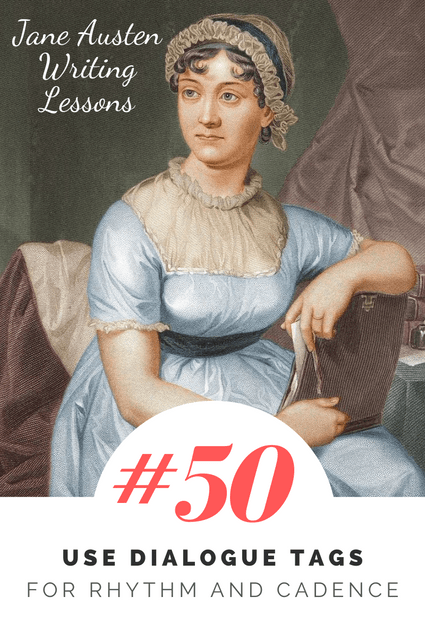
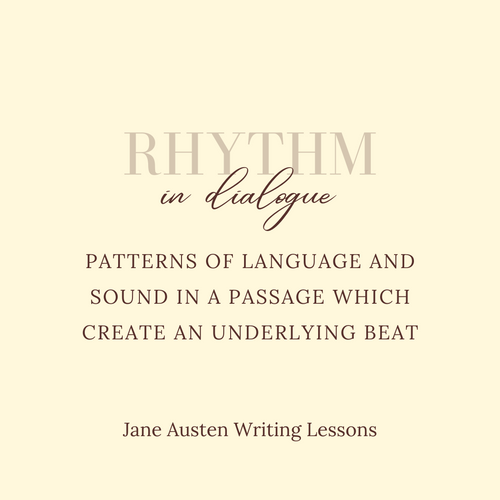
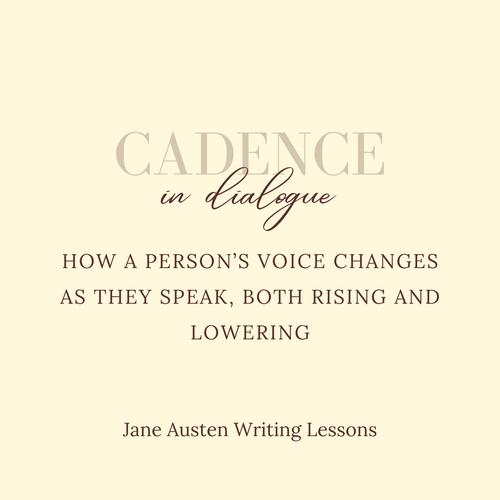
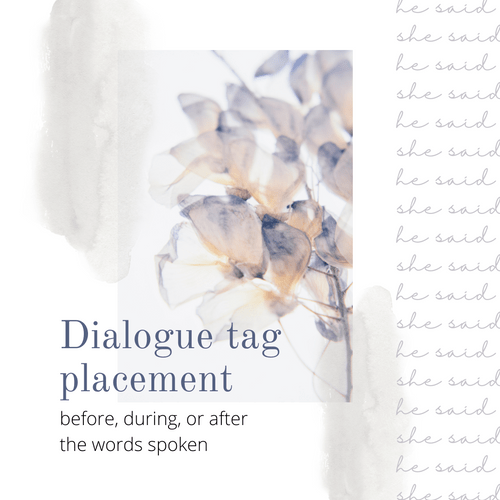

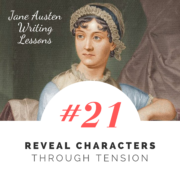
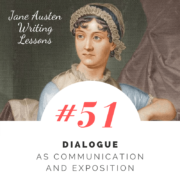
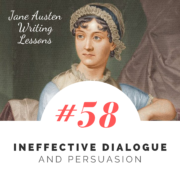
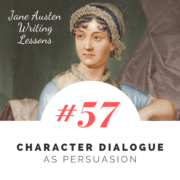
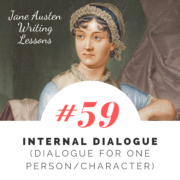
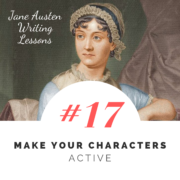


Leave a Reply
Want to join the discussion?Feel free to contribute!